Description
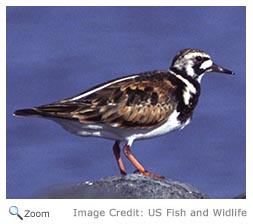 The ruddy turnstone is a short-legged shore bird that is about 7 inches in length. It has a short, dark bill that is slightly upturned at the end; black and white markings on its head; and a black patch on its chest. It legs are yellow to orange-red. In summer, its uppersides are a combination of white, rusty-red and black. In winter, it is grayish-brown above. The ruddy turnstone is a short-legged shore bird that is about 7 inches in length. It has a short, dark bill that is slightly upturned at the end; black and white markings on its head; and a black patch on its chest. It legs are yellow to orange-red. In summer, its uppersides are a combination of white, rusty-red and black. In winter, it is grayish-brown above.
Range
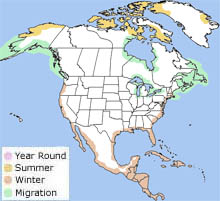 The ruddy turnstone breeds along the coastline from western Alaska east to Greenland. The ruddy turnstone also breeds in arctic regions of Europe and Asia. It winters along the Pacific and Atlantic Coasts from Oregon and Connecticut south to South America. It also winters on the Gulf Coast. The ruddy turnstone breeds along the coastline from western Alaska east to Greenland. The ruddy turnstone also breeds in arctic regions of Europe and Asia. It winters along the Pacific and Atlantic Coasts from Oregon and Connecticut south to South America. It also winters on the Gulf Coast.
Habitat
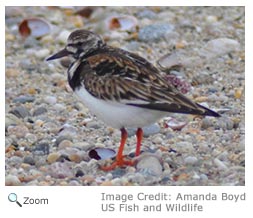 During breeding season, the ruddy turnstone can be found on coastal tundras. In winter, it can be found in a variety of habitats near the water including mudflats, sandbars, sandy or muddy shores, beaches, and rocky coasts. During breeding season, the ruddy turnstone can be found on coastal tundras. In winter, it can be found in a variety of habitats near the water including mudflats, sandbars, sandy or muddy shores, beaches, and rocky coasts.
|
|
Diet  The ruddy turnstone flips over rocks looking for small animals underneath them. It also digs into the sand in pursuit of crustaceans. It eats a variety of animals including small mollusks, crustaceans, grasshoppers, insects, larvae, maggots, worms, the eggs of horseshoe crabs, and tern's eggs. The ruddy turnstone flips over rocks looking for small animals underneath them. It also digs into the sand in pursuit of crustaceans. It eats a variety of animals including small mollusks, crustaceans, grasshoppers, insects, larvae, maggots, worms, the eggs of horseshoe crabs, and tern's eggs.
Life Cycle
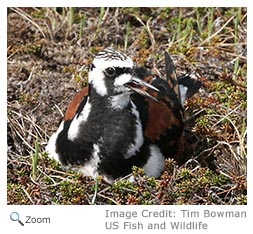 Males and females pair off either before or after reaching their breeding ground. Nests are made in open areas near the water. The female lays 4 eggs in a grassy area. Both parents incubate the eggs. Males are very territorial and will patrol the border of the nesting site and will aggressively chase away any intruders. The chicks hatch in 22-24 days and fledge when they are 19-21 days old. Both parents care for the young. The female leaves before the chicks fledge. leaving the male to care for the chicks until they fledge. Males and females pair off either before or after reaching their breeding ground. Nests are made in open areas near the water. The female lays 4 eggs in a grassy area. Both parents incubate the eggs. Males are very territorial and will patrol the border of the nesting site and will aggressively chase away any intruders. The chicks hatch in 22-24 days and fledge when they are 19-21 days old. Both parents care for the young. The female leaves before the chicks fledge. leaving the male to care for the chicks until they fledge.
Behavior
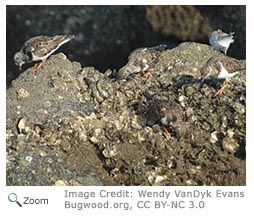 The turnstone gets its name from its habit of turning over stones when it looks for food. It is also sometimes called the seaweed bird because it often feeds among the kelp at low tide. It is a very good swimmer and may spend hours bathing and preening. The turnstone gets its name from its habit of turning over stones when it looks for food. It is also sometimes called the seaweed bird because it often feeds among the kelp at low tide. It is a very good swimmer and may spend hours bathing and preening.
|